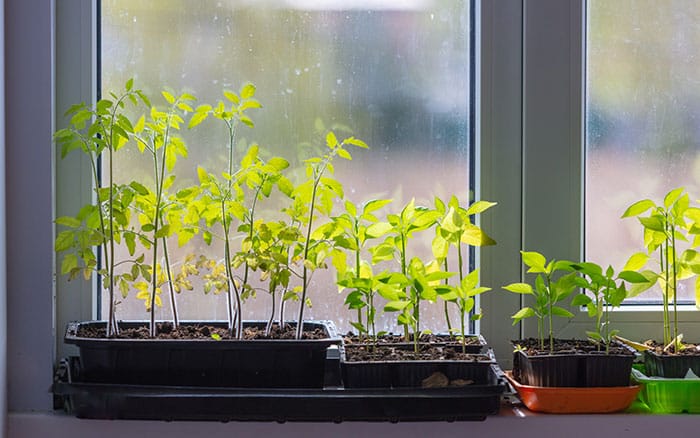Whether you have a cultivated corner or a few pots on your patio, you can learn how to grow productively. Find out some thrifty tips and tricks to make the most out of your plot.
How to grow without a garden
When it comes to garden-free growing, many manage to enjoy the rewards of microgreen and herb growing indoors. These are quick and compact, growing in small pots quite happily on a windowsill.
Hydroponics also give you the ability to grow indoors and work well for cut and come-again crops. However, these indoor growing setups don’t always measure up, and so many use community gardens and allotments for outdoor space.
But, as land can come at a premium, here are a load of clever ideas to generate more harvests. Large gardens can benefit from bigger crop production, whilst small gardens can take steps towards packing out their patch.

How to pack out your garden plot
Whether you’re growing at home or in a communal space, you’ll want to get the most bang for your buck. Getting organised will give you a streamlined approach to growing, here’s how:
1. Crop rotation
This involves so much more than just improving soil fertility and nutrition. It even has benefits beyond building resistance against disease and pests. Though these consequences are helpful towards reducing waste, a well-thought-out rotation plan can help maximise space, key for small plots. Within your rotation plan, work out watertight timings—have seedlings ready to plant when you’re next due to harvest. This is called relay cropping and it will mean that no patch of soil is left empty. Transplanting seedlings this way also allows root systems to be established before planting out so specimens are quicker to mature.
Intercropping
Involving growing two or more crops in proximity, and is usually used to improve growing conditions. Also, this can be great for space saving. For example, plant deep-rooted brassica crops alongside shallow-rooted cut-and-come-again lettuce mixtures. This works too for positioning tall crops next to low growers that tolerate shade, like spinach. This way, both plants access adequate growing conditions, but you’ve saved on planting them in two different spots. Temporal intercropping uses a similar method but involves sowing fast-growers – like radishes – with slow-growing peas, for instance. The quick crop can be harvested before the slow crop matures—you literally get two for one!


2. Dwarf Varieties
These lend themselves to small-scale setups. So, as well as how you’re planting, consider what you’re planting. Try to avoid growing crops that take up a lot of space overground (such as asparagus, or maincrop potatoes). But some vegetables can be bought in bush varieties, like with courgettes and pumpkins, instead of traditional long, trailing kinds. You can also go for mini or baby veg varieties that typically start cropping early. Otherwise, the compact habits of dwarf bush rootstock, like cultivar Malus domestica ‘Discovery’, will work well in petite plots.
As a clue, look out for anything named patio, pixie, tiny, baby, or dwarf. Just because a plant is bred to be small, don’t make the mistake of thinking the fruits will be small or less plentiful. So, pick what you plant carefully, and it will pay dividends.
3. Pots & Containers
A really useful option, but don’t stop there. Potatoes grow well in confined spaces, like dustbins, and grow bags are ideal for raising seedlings where space is restricted. Use portable containers like this to utilise areas with tough growing conditions. For shaded corners, try loose-leaf lettuces including varieties such as ‘Lollo Rosso’ or fast-growing, spicy mizuna leaves. Radishes will also do well in shady areas and can be ready within a few weeks of sowing. Though Mediterranean herbs are best for sun-baked soils, herbs like Moroccan mint can be grown in shade and mint is fantastic to cook with. Naturally suited to dappled light, woodland fruits like white currants, redcurrants and blackcurrants or berries – such as blackberries and alpine strawberries – are also perfect for such positions.


4. Utilise Height
Particularly helpful in small spaces. If you’ve only a sliver of land left, why not grow upwards! Put up a wall to grow on and then cut the sides off used plastic water bottles and screw them to the wall. Even a half tyre simply filled with soil can serve as ample growing space when fixed to a tall structure and you can fill these with anything you like.
Trellising cucumbers to grow vertically can be accomplished by planting so that the stems are roughly 4 inches away from the structure. The tendrils will weave upwards as they grow instead of trailing across the ground. Similarly, you can do this with heavy-yielding climbing runner beans too—even an archway placed over a path can do it. Additional to this, the espalier technique for training the branches of fruit trees to spread them out flat can be hugely effective and decorative.
5. Design Your Space
Make sure your garden works for you. Why not stop planting in rows and give triangles a try instead? This really optimises space to accommodate more crops per area. Raised beds also have the ability to yield more than when planting in rows. That’s due not only to their loose, fertile soil but to mounding the soil upwards to form an arc. A rounded bed can make a big difference in the total planting area. Grow lettuce, spinach, and other greens on the edges of a rounded bed and you’ll have produced more crops without even trying.

You don’t need bundles of space for an abundant bounty, small spaces have a lot to offer. And now you know how to make the most out of them, you’ll be a growing pro in no time.

Leave A Comment